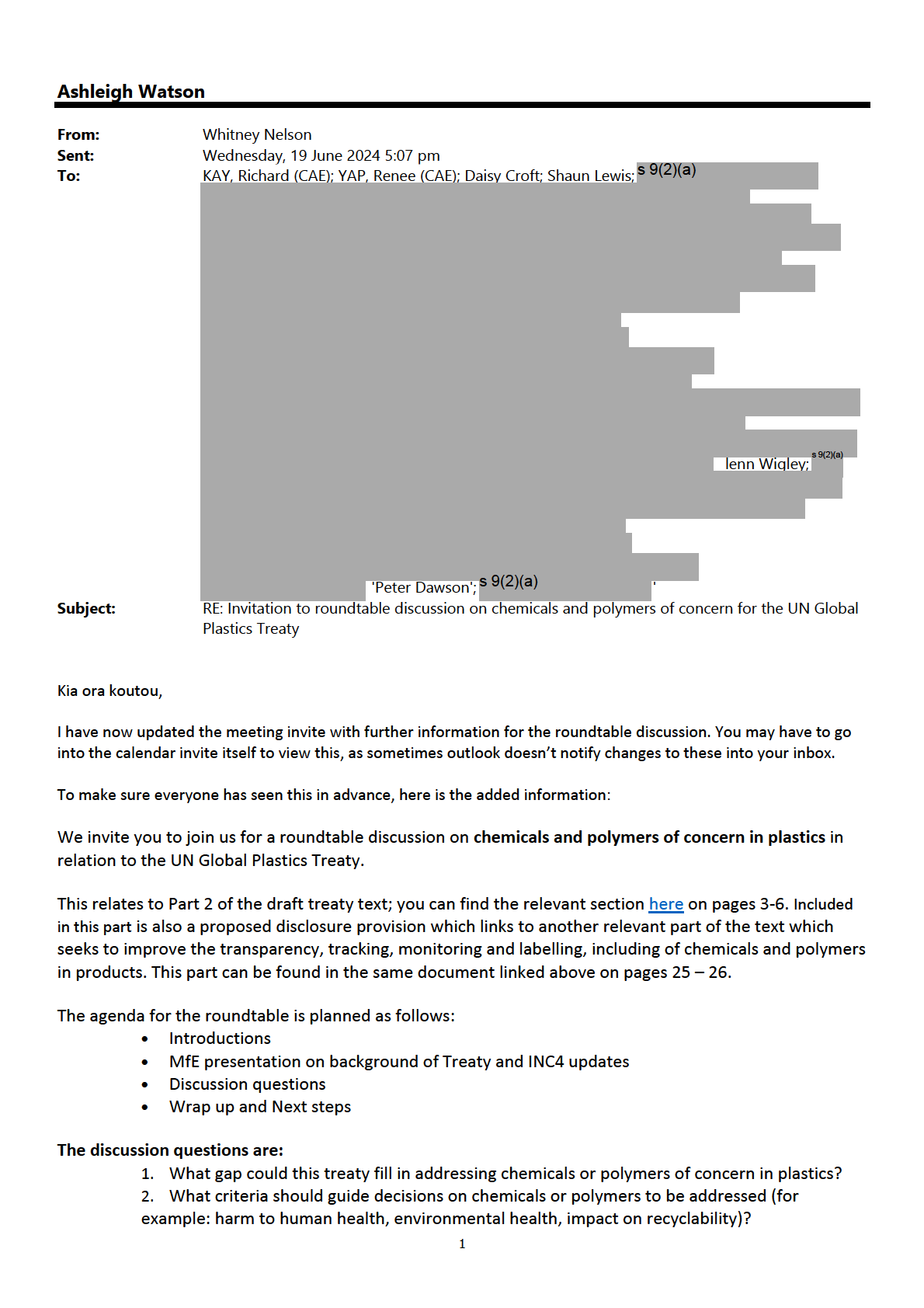








3. What are the pros and cons for criteria and lists of targeted chemicals and polymers being
set globally versus at the national level?
4. What provisions should be voluntary and what provisions should be legally binding?
5. What specific chemicals or polymers used in plastics should be addressed or excluded from
the Treaty (for example, there might not yet be suitable alternatives)?
6. What are your views on improved disclosure requirements for chemicals and polymers in
plastics?
7. Is there anything else you want to discuss today or any resources/research you want to
share with the group?
The United Nations Environment Programme released a technical report on the state of knowledge on
chemicals in plastics, which may be useful for your reference. Please find the link to this report here.
We look forward to seeing you there. Please reach out if you have any questions.
Ngā mihi, nā
Whitney Nelson (she/her)
Senior Policy Analyst | Kaitātari Kaupapa Here Matua Waste Streams and Plas cs Policy | Te Kaupapa Here Mō Ngā Nekehanga Para
Waste Systems | Te Rōpu Ngā Pūnaha Para
Ministry for the Environment | Manatū Mō Te Taiao
[email address] | environment.govt.nz
Ministry staff work flexibly by default. For me this means I work Monday to Friday from 7:30am to 3:30pm.
From: Whitney Nelson
Sent: Monday, June 10, 2024 5:14 PM
To: s 9(2)(a)
2








s 9(2)(a)
Cc: Daisy Croft <[email address]>
Subject: Invitation to roundtable discussion on chemicals and polymers of concern for the UN Global Plastics Treaty
Kia ora koutou,
The fourth round of negotiations (INC4) for the UN Global Plastics Treaty took place in April. As we look towards the
fifth round of negotiations (INC5) in November 2024, we would like to invite you to a roundtable discussion on
topics that may be of interest to you.
The first roundtable will be focused
chemicals and polymers of concern in plastics. This relates to Part 2 of the draft
treaty text; you can find the relevant section here: pages 3‐6.
The roundtable is to discuss our stakeholders’ perspectives and identify common or diverging views or interests. We
would also like to give you the opportunity to learn more about the treaty‐making process, as well as build
connections with others. If our stakeholders find the session valuable, we may hold further roundtables on other
topics over the coming months, in the lead‐up to INC5.
We have sent this invitation to people and organisations who have shown interest in the treaty negotiations (or
other stakeholders may have recommended we include you!). Please let us know if you think anyone is missing. You
may also forward this onto someone else within your organisation who is best placed to attend.
At INC4 in April, countries worked on streamlining a (previously very expansive) text. Countries also agreed to
establish two expert groups to work ahead of INC‐5. You can read more about the groups’ work here. One of the
topics for the expert groups to consider is chemicals and polymers of concern. This is why we have selected this
topic for the first roundtable.
If you are interested in attending, please let us know your availability to attend on either Monday 24 June, 3 –
4:30pm or Tuesday 25 June, 1:30 – 3pm by voting your preference here.
We’ll include final details in the meeting invitation, along with questions that we will use to guide the discussion.
For more information on the treaty, please see our webpage, though please note we are currently working on
updating this with our revised Cabinet mandate.
We look forward to your response. Please reach out if you have any questions.
Ngā mihi, nā,
Whitney Nelson (she/her)
Senior Policy Analyst | Kaitātari Kaupapa Here Matua Waste Streams and Plas cs Policy | Te Kaupapa Here Mō Ngā Nekehanga Para
Waste Systems | Te Rōpu Ngā Pūnaha Para
Ministry for the Environment | Manatū Mō Te Taiao
[email address] | environment.govt.nz
Ministry staff work flexibly by default. For me this means I work Monday to Friday from 7:30am to 3:30pm.
3

4


2
Summary of discussion – Roundtable discussion on chemicals and polymers of concern
Tuesday 25 June
Question 1: What gap could this treaty fill in addressing chemicals or polymers of concern in plastics?
There were mixed views on whether an international plastics treaty is the right place for the
regulation of chemicals in plastics. However, there was broad agreement that chemicals of concern
exist in a range of materials, not just plastics.
One view shared was that only a small portion of the chemicals found in plastics are regulated in other
MEAs, and so chemicals in plastics should be regulated through this treaty. Most participants agreed
there should also be flexibility to link with other global initiatives to allow the management of chemicals
in other materials too.
Another view shared was that there are other MEAs that are more appropriate to handle chemicals of
concern in plastics. Some shared the concern that this treaty could create a bias against plastics, when
these chemicals are also used in other products/industries. Similarly, the risk of unintended
consequences of moving to alternative materials was raised.
It was mentioned that the UNEP technical report of the state of knowledge in plastics identified over
16,000 chemicals used in plastics, and that 1 to 4% of these chemicals are regulated globally. There was
disagreement with this statistic, and that there are only about 4,000 to 6,000 chemicals in active use in
plastics (with information still be gathered on this by global plastic producers).
Question 2: What criteria should guide decisions on chemicals or polymers to be addressed (for example:
harm to human health, environmental health, impact on recyclability?)
There were mixed views on whether or not chemicals management should adopt a hazard-based
approach or a risk-based approach.
One view shared was that there needs to be a hazard-based approach to developing criteria for
chemicals and polymers of concern. Another view shared was that a risk-based approach would be more
appropriate.
There was some discussion about a positive-list approach (or an inclusive framework), rather than
banning or restricting certain chemicals. New chemicals would be required to be registered and
approved before use. A positive list would ensure a precautionary approach is taken, particularly where
it is challenging to assess toxicity. There was a suggestion that chemicals on a positive list could be
required to comply with EU chemicals strategy for sustainability, and that the list would be open and
adaptive to the latest and best available science. Some shared the need for any chemicals management
to consider essentiality. Essentiality or the essential use concept is intended to limit the use of the most
harmful chemicals to situations where they can be demonstrated to be necessary for health and safety
or to serve an essential function to society.
There was also some discussion about a risk-based scientific approach (as opposed to the hazard-based,
positive list suggestions above). It was noted that the implementation of a positive list, approval-based
system may be difficult (i.e. compliance, testing). There was some concern that targeted lists do not
consider application or use, and any chemicals management would therefore need to look at the
context of where and how the chemical is used rather than just target the chemical itself. Again, the
point around managing chemicals across industries and materials (not just plastics) was raised.
Question 3: What are the pros and cons for criteria and lists of targeted chemicals and polymers being
set globally versus at the national level?
There was general agreement that criteria and lists of targeted chemicals and polymers should be
developed at a global level, and that criteria should include application or essentiality of the chemical
or polymer of concern.
Multiple views were shared supporting criteria and lists of targeted chemicals to be developed at a
global level. Reasons for this included that global criteria and lists would:
• create a level playing field for NZ manufacturers
• be more protective for NZ local markets
• provide clear global signaling for investments into research and development, and
• would be particularly useful when it comes to protecting human health and environmental
harm.
There was a point raised that any criteria or lists need to consider where and how the chemical or
polymer of concern is used.
There was a point raised that legally binding global standards would not be effective unless they are
associated with reporting compliance and enforcement measures.
Question 4: What provisions should be voluntary or legally binding?
There was general agreement that provisions should be legally binding, rather than voluntary.
There was broad agreement that provisions should be legally binding. Many commented that legally
binding rules will drive change and that voluntary measures in existing frameworks are not effective.
Another view was shared that some provisions could be voluntary so there is the ability to go above and
beyond what the provision requires.
One view shared was that regardless of whether provisions are voluntary or legally binding, they will
likely have minimal difference on local industry because raw plastics materials are imported to NZ. It
was noted that we need to make sure NZ’s implementation of any legally binding provisions does not
place high costs and barriers for our local manufacturers and exporters.
There was discussion on how any legally binding provisions would be enforced, because we receive raw
plastics materials from other countries. It was shared that the policing of imported plastics to NZ may be
hard to implement as customs data currently assesses imports as items rather than the material they
are made from. There was agreement that there would be a need for transparency and traceability for
these global standards.
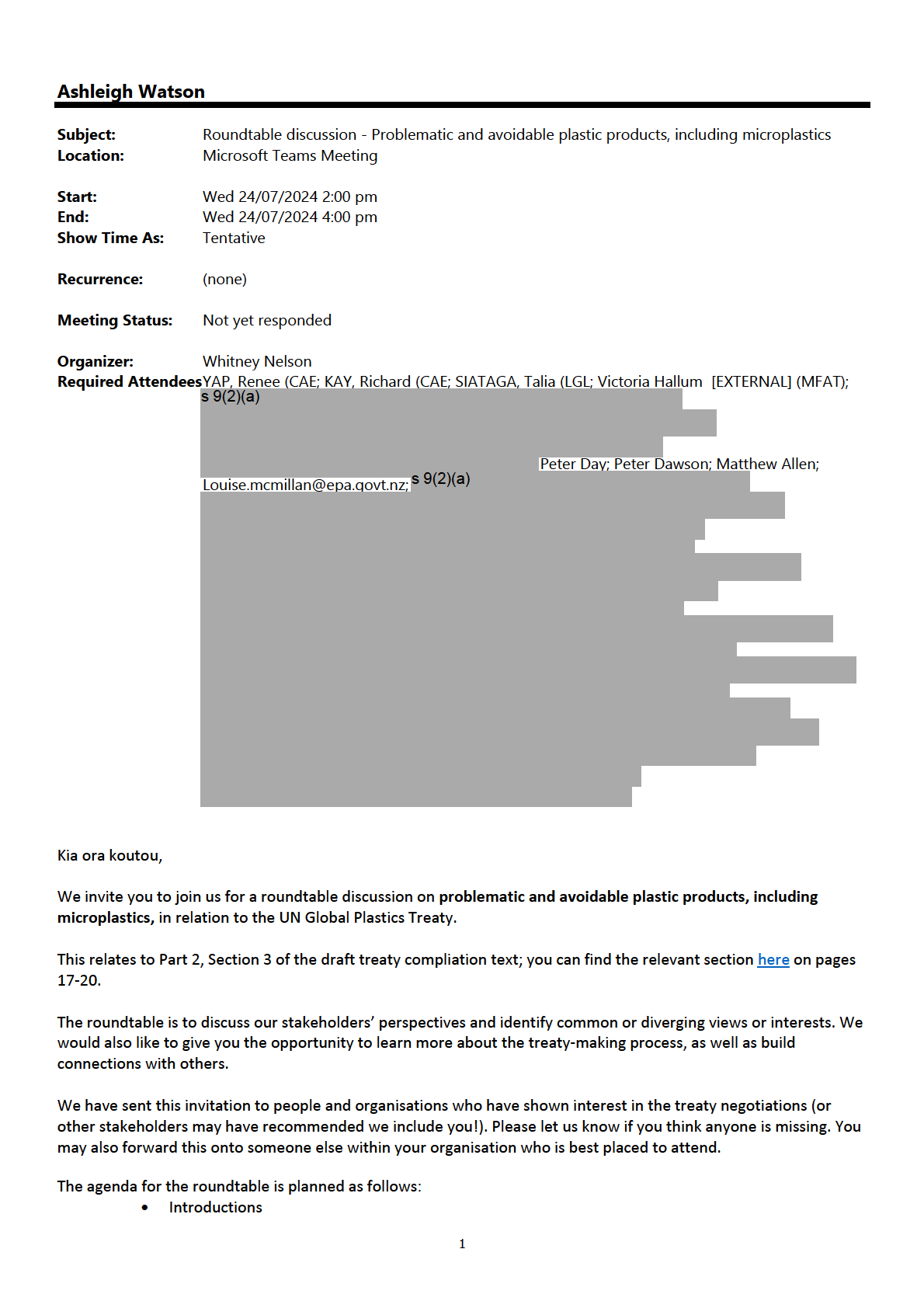
MfE presentation on background of Treaty and INC4 updates
Discussion questions
Wrap up and Next steps
The discussion questions used to guide the roundtable will be updated here no later than Wednesday 17 July.
We look forward to seeing you there. Please reach out if you have any questions.
Ngā mihi, nā
Whitney
________________________________________________________________________________
Microsoft Teams Need help?
Join the meeting now Meeting ID: 469 634 152 361
Passcode: Mof7KY
Dial in by phone +64 4-889 8018,,510959013# New Zealand, Wellington
Find a local number
Phone conference ID: 510 959 013#
For organizers: Meeting options | Reset dial-in PIN
Ministry for the Environment
________________________________________________________________________________
2
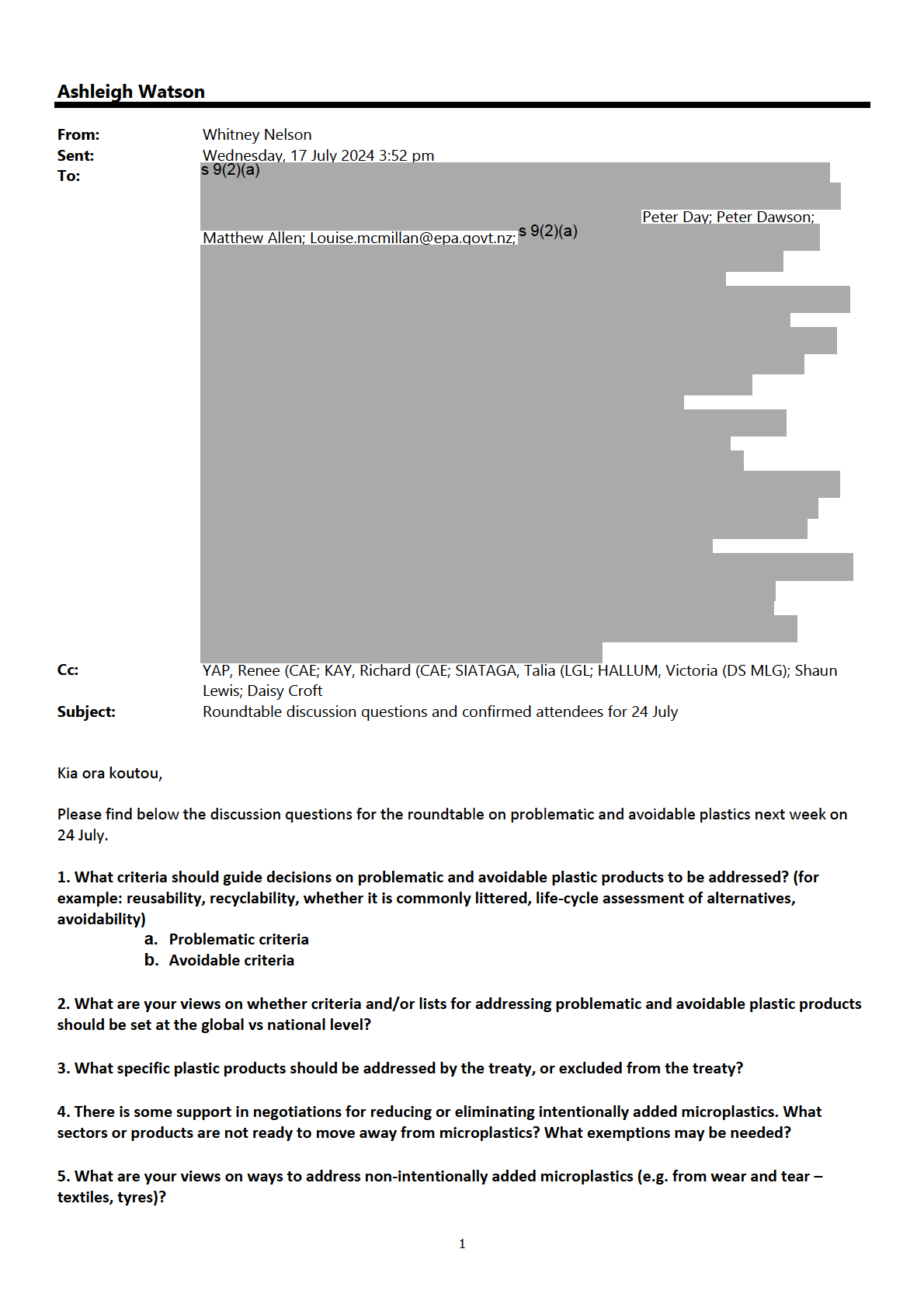
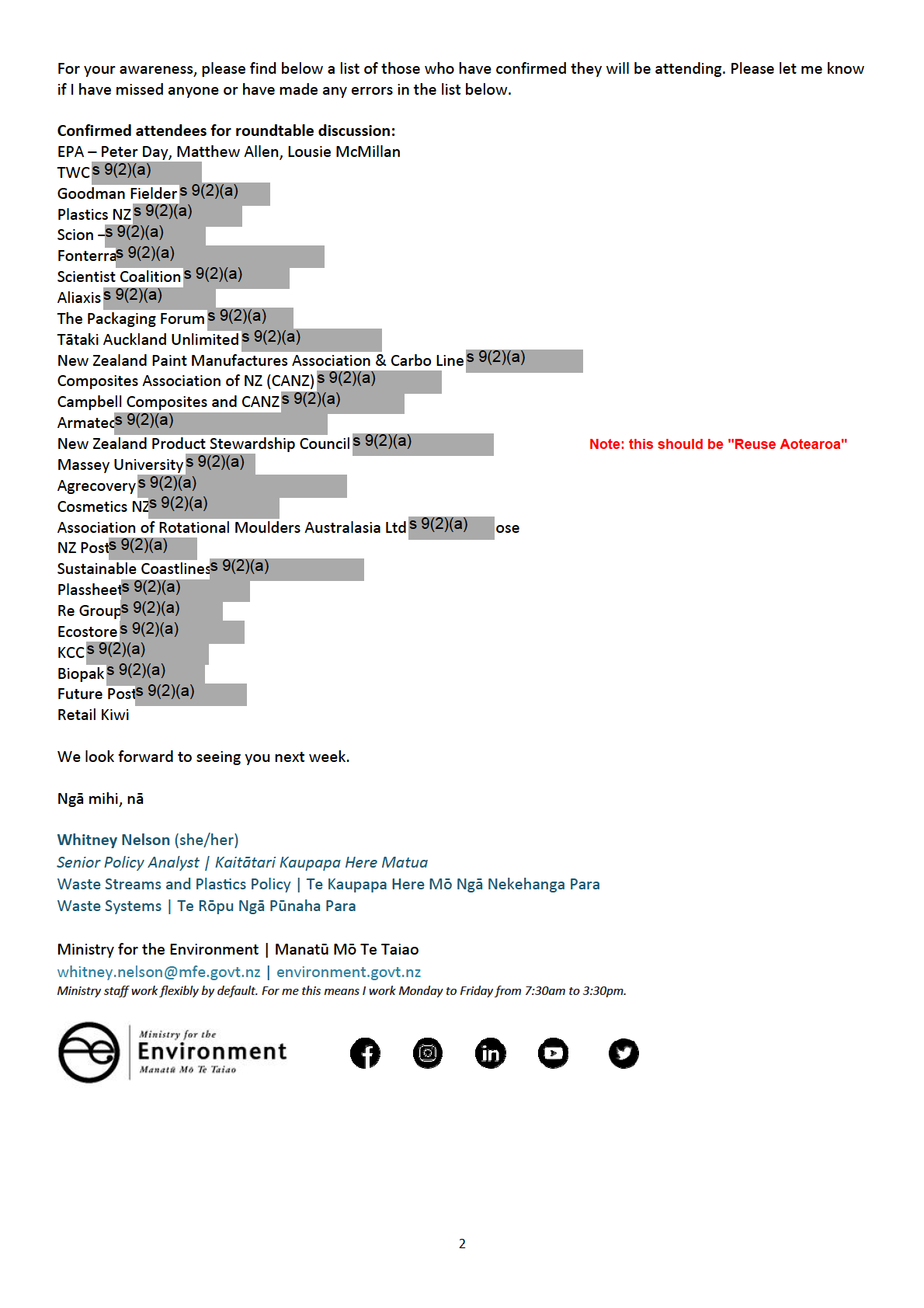

3
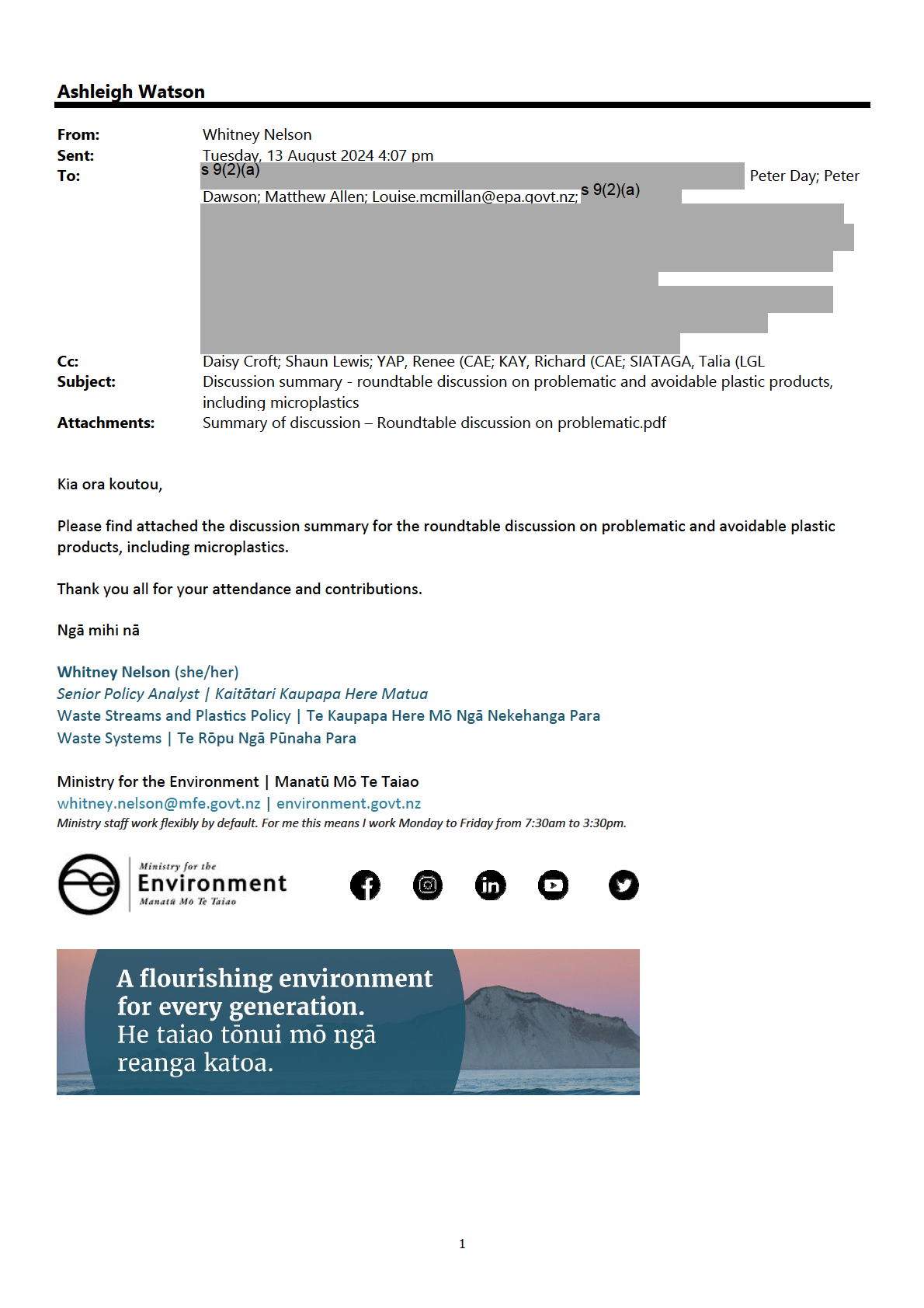
Summary of discussion – Roundtable discussion on problematic and avoidable plastic products,
including microplastics.
Wednesday 24 July
List of attendees
EPA – Peter Day, Matthew Allen, Louise McMillan, Peter Dawson
TWC s 9(2)(a)
Goodman Fielder s 9(2)(a)
Plastics NZs 9(2)(a)
Scion s 9(2)(a)
Fonterra s 9(2)(a)
Scientist Coalition –s 9(2)(a)
Aliaxis s 9(2)(a)
The Packaging Forum s 9(2)(a)
Composites Association of NZ (CANZ)s 9(2)(a)
Campbell Composites and CANZ s 9(2)(a)
Massey University s 9(2)(a)
Agrecoverys 9(2)(a)
Cosmetics NZs 9(2)(a)
Sustainable Coastlines s 9(2)(a)
Ecostore s 9(2)(a)
Biopak s 9(2)(a)
Future Post s 9(2)(a)
Retail Kiwi
Foodstuffss 9(2)(a)
Southern Pastures, Lewis Road Creamery s 9(2)(a)
PwC and SteerCo for Plastics Packaging Product Stewardship Co-Design Schemes 9(2)(a)
Pact Group s 9(2)(a)
ESRs 9(2)(a)
New Zealand Food and Grocery Council s 9(2)(a)
University of Auckland s 9(2)(a)
Problematic and avoidable plastic products
1. What criteria should guide decisions on problematic and avoidable plastic products to be addressed?
(for example: reusability, recyclability, whether it is commonly littered, life-cycle assessment of
alternatives, avoidability)
a. Problematic criteria
b. Avoidable criteria
There was general agreement that criteria should include essentiality, and this must be clearly
defined. It was also generally agreed that essentiality should be able to be applied to different
countries to reflect different circumstances. The idea of a decision tree for criteria was raised, and this
was supported by others. There was agreement that the term ‘recyclable’ also needs to be defined in
the treaty context.
‘Essentiality’ as a criteria
Multiple people shared that criteria should include essentiality, including that:
• There need to be clear rules for exceptions to essentiality.
• The definition of essentiality should look at micro biological risks and prioritise food safety for
food plastic packaging.
• Essentiality could be interpreted quite differently depending on sector and national
circumstances.
One view shared was that criteria could be developed as a decision tree (involving criteria such as
whether the products can be recycled, the waste hierarchy etc.).
Some participants also supported a decision tree, and noted the waste hierarchy is important as an early
part of this decision tree, with national circumstances considered to support a just transition.
Implementation
There was a brief discussion around practical implementation – specifically, the complexity of potential
requirements to assess every single plastic product or component that comes into the country. MfE
noted that we don’t know exactly what the requirements will be at this stage, but one possibility is that
criteria would guide technical expert groups to make decisions on products for regulating. Another
possibility is that criteria are set globally and countries have to implement those criteria accordingly.
Another view shared was that the instrument should not require assessment of every plastic item that is
circulating in the economy, but instead start with lists of those items deemed most hazardous and
problematic, and build on this list over time.
It was noted that manufacturers are already dealing with a lot of compliance issues, and this treaty
would establish another set of compliance regulations to be followed and the question was raised on
who would hold responsibility for reporting on this compliance.
Definition of ‘recyclable’
There was some discussion about the definition of ‘recyclable’, including that:
• It may need to be defined at the global, national and regional level
• Recyclability should refer not just to whether or not a product can be recycled, but also whether
it impacts on the recyclability of other products.
2. What are your views on whether criteria and/or lists for addressing problematic and avoidable plastic
products should be set at the global vs national level? There were mixed views on whether criteria and/or list should be used for addressing problematic
and avoidable plastic products. There was broad support for addressing products at both the global
and the national level.
There was some discussion around the use of lists. One participant did not support the use of lists for
plastic products and instead supported a risk-based approach where hazard and exposure are
considered together to determine risk. Criteria must allow for the consideration of the diverse use of the
products (i.e. there are products that may only be problematic in certain applications/uses). Another
participant agreed that lists would be ineffective and that it may be difficult to regulate plastic imports
with lists.
There was some discussion about the need for regulation to be applied and enforced at the start of the
plastics value chain, making it easier for importers to know what is recyclable or reusable.
There was some support for criteria being set and applied at a national level to account for differing
infrastructure (for example, something that is recyclable in practice and at scale overseas may not be
recyclable in NZ). Another participant added that in addition to nationally set criteria there could also be
a simplified global approach.
3. What specific plastic products should be addressed by the treaty, or excluded from the treaty?
Different views were shared on the definition of ‘plastics.’
One participant shared that plastic products that have already
been assessed or regulated at the
national level should be priority products to start with to be regulated.
There was a brief discussion about the definition of the word ‘plastics’ in the Treaty. MfE noted that the
Treaty has not clearly defined ‘plastics’ yet. One participant noted that there is a grey area for when
something stops being a polymer and when it becomes a plastic. Another participant shared that their
definition of plastic is “plastic materials made of synthetic and semi-synthetic polymers that are used for
the first time to create plastic products in any form.”
Microplastics
4. There is some support in negotiations for reducing or eliminating intentionally added microplastics.
What sectors or products are not ready to move away from microplastics? What exemptions may be
needed?
5. What are your views on ways to address non-intentionally added microplastics (e.g. from wear and
tear – textiles, tyres)?
There was agreement that the term ‘microplastics’ and ‘intentionally added microplastics’ need to be
defined, and there needs to be clarity on whether primary microplastics are intended to be included in
the treaty.
One participant supported eliminating intentionally added microplastics and also raised that microfibers
are also microplastics that should be focused on.
There was discussion on the definition of ‘intentionally added microplastics’ and differing views on what
types of microplastics should be addressed in the treaty. Some agreed that the term microplastics
should include pellets, flakes and powders. Some agreed that the term should apply to microplastics
added as an ingredient for the product, and not apply to pellets, flakes and powders used to
manufacture plastics.
There was a brief discussion on focusing on designing plastic products for durability and circularity.
One participant shared that microplastics in cosmetics have been banned in NZ since 2018. There is an
international association collaboration where all cosmetic associations globally are looking at how best
to support the treaty and what can be done to reduce plastics.
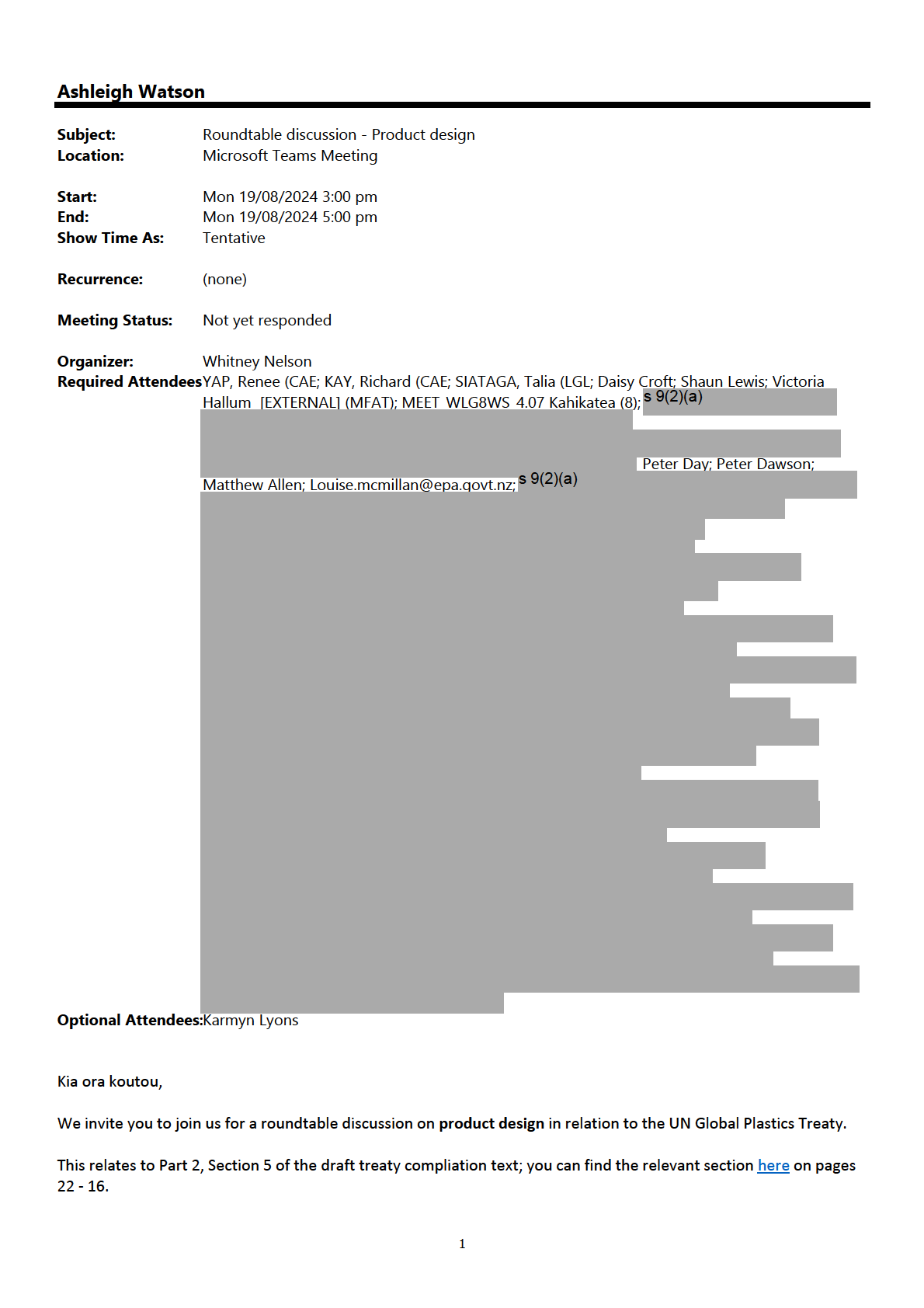
The roundtable is to discuss our stakeholders’ perspectives and identify common or diverging views or interests. We
would also like to give you the opportunity to learn more about the treaty‐making process, as well as build
connections with others.
We have sent this invitation to people and organisations who have shown interest in the treaty negotiations (or
other stakeholders may have recommended we include you!). Please let us know if you think anyone is missing. You
may also forward this onto someone else within your organisation who is best placed to attend.
The agenda for the roundtable is planned as follows:
Introductions
MfE presentation on background of Treaty and INC4 updates
Discussion questions
Wrap up and Next steps
Discussion questions TBC – will be added here no later than Mon 12th
Ngā mihi, nā
Whitney
________________________________________________________________________________
Microsoft Teams Need help?
Join the meeting now Meeting ID: 455 286 801 218
Passcode: dSLd57
Dial in by phone +64 4-889 8018,,346960020# New Zealand, Wellington
Find a local number
Phone conference ID: 346 960 020#
For organizers: Meeting options | Reset dial-in PIN
Ministry for the Environment
________________________________________________________________________________
2









 Confirmed attendees for roundtable discussion:
Confirmed attendees for roundtable discussion: Fonterra
Carboline
The Packaging Forum
Agrecovery
Plasback
Christchurch City Council –
Food and Grocery Council
Zero Waste
Armatec
)
Scientist Coalition
Goodman Fielder
ESR
Tātaki Auckland Unlimited
New Zealand Product Stewardship Council
Note: this should be "Reuse Aotearoa"
Composites Association of NZ (CANZ)
TWC
Biopak –
Auckland Council
Cosmetics NZ
Used fully
Jadcup
We look forward to seeing you next week.
Ngā mihi, nā
Whitney Nelson (she/her)
Senior Policy Analyst | Kaitātari Kaupapa Here Matua Waste Streams and Plas cs Policy | Te Kaupapa Here Mō Ngā Nekehanga Para
Waste Systems | Te Rōpu Ngā Pūnaha Para
Ministry for the Environment | Manatū Mō Te Taiao
[email address] | environment.govt.nz
Ministry staff work flexibly by default. For me this means I work Monday to Friday from 7:30am to 3:30pm.
2



































